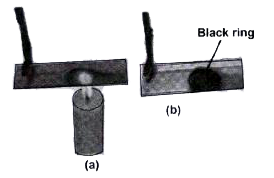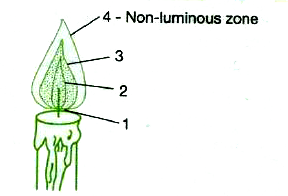What is the blue zone in a candle flame?
Step-by-Step Text Solution:
1. Understanding Candle Flame Structure: A candle flame consists of different zones, each with distinct characteristics. The flame can be divided into three main zones: the inner zone, the middle zone, and the outer zone.
2. Identifying the Blue Zone: The blue zone of a candle flame is the outermost part of the flame. It is characterized by its blue color, which indicates a specific type of combustion.
3. Complete Combustion: The blue zone is associated with complete combustion. This occurs when there is an adequate supply of oxygen available for the wax (fuel) to burn completely.
4. Excess Supply of Oxygen: In the blue zone, there is an excess supply of oxygen. This allows the carbon in the wax to combine fully with oxygen, producing carbon dioxide and water vapor as the main products.
5. Non-Luminous Flame: The flame in the blue zone is known as a non-luminous flame. This means it does not emit light in the same way that the inner, yellowish part of the flame does, which is due to incomplete combustion.
6. Hottest Part of the Flame: The blue zone is also the hottest part of the candle flame. The complete combustion process in this zone releases more energy, resulting in higher temperatures compared to other zones.
Summary:
The blue zone in a candle flame is the outermost part where complete combustion occurs due to an excess supply of oxygen. It is a non-luminous flame and is the hottest part of the candle flame.
---
The blue zone in a candle flame is the outermost part where complete combustion occurs due to an excess supply of oxygen. It is a non-luminous flame and is the hottest part of the candle flame.
Topper's Solved these Questions
- COMBUSTION AND FLAME BOOK - MTG IIT JEE FOUNDATIONCHAPTER - COMBUSTION AND FLAME EXERCISE - SOLVED EXAMPLE
15 Videos
- COMBUSTION AND FLAME BOOK - MTG IIT JEE FOUNDATIONCHAPTER - COMBUSTION AND FLAME EXERCISE - NCERT SECTION
18 Videos
- COAL AND PETROLEUMBOOK - MTG IIT JEE FOUNDATIONCHAPTER - COAL AND PETROLEUMEXERCISE - OLYMPIAD/HOTS CORNER
10 Videos
- FOOTSTEPS TOWARDS (JEE MAIN)BOOK - MTG IIT JEE FOUNDATIONCHAPTER - FOOTSTEPS TOWARDS (JEE MAIN)EXERCISE - SECTION B (NUMBERIC VALUE TYPE QUESTIONS)
10 Videos
Similar Questions
Knowledge Check
When you introduce a glass plate into the luminous zone of a candle flame for a few seconds, the observation is as shown in figure (b). What does the observation indicate?
 ADeposition of burnt CO2 particles present in the air around the flame.BDeposition of unburnt carbon particles in the luminous zone of the flame.CDeposition of molten wax.DAll of these.
ADeposition of burnt CO2 particles present in the air around the flame.BDeposition of unburnt carbon particles in the luminous zone of the flame.CDeposition of molten wax.DAll of these.______ combustion is the reason why a candle flame is yellow in colour.
AIncompleteBCompleteCRapidDSpontaneousThis zone is also called the zone of ____ in a candle flame.
AIncomplete combustionBno combustionCComplete combustionDPartial combustion
Name the various zones of a candle flame. Which zone (or part) of a candle flame is the least hot (or coldest)?
View SolutionHow will you prove that
the non-luminous zone of a candle flame is the hottest zone?
View SolutionHow will you prove that luminous zone of a candle flame contains unburnt particles of carbon? Demonstrate with an experiment.
View SolutionWhy luminous zone is yellow in colour in a candle flame?
View SolutionIn order to understand the structure of a flame, light a wax candle and watch its flame. Carefully note the different coloured zones in the flame. Starting from the base of the flame, a flame has three zones. Check the below figure and try to answer the following question

Expalin why dark zone is the coldest part of a candle flame.
View Solution